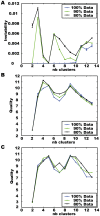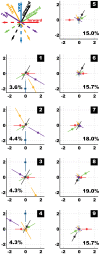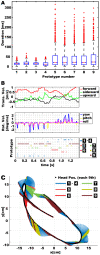Identifying prototypical components in behaviour using clustering algorithms
- PMID: 20179763
- PMCID: PMC2825265
- DOI: 10.1371/journal.pone.0009361
Identifying prototypical components in behaviour using clustering algorithms
Abstract
Quantitative analysis of animal behaviour is a requirement to understand the task solving strategies of animals and the underlying control mechanisms. The identification of repeatedly occurring behavioural components is thereby a key element of a structured quantitative description. However, the complexity of most behaviours makes the identification of such behavioural components a challenging problem. We propose an automatic and objective approach for determining and evaluating prototypical behavioural components. Behavioural prototypes are identified using clustering algorithms and finally evaluated with respect to their ability to represent the whole behavioural data set. The prototypes allow for a meaningful segmentation of behavioural sequences. We applied our clustering approach to identify prototypical movements of the head of blowflies during cruising flight. The results confirm the previously established saccadic gaze strategy by the set of prototypes being divided into either predominantly translational or rotational movements, respectively. The prototypes reveal additional details about the saccadic and intersaccadic flight sections that could not be unravelled so far. Successful application of the proposed approach to behavioural data shows its ability to automatically identify prototypical behavioural components within a large and noisy database and to evaluate these with respect to their quality and stability. Hence, this approach might be applied to a broad range of behavioural and neural data obtained from different animals and in different contexts.
Conflict of interest statement
Figures










Similar articles
-
A syntax of hoverfly flight prototypes.J Exp Biol. 2010 Jul 15;213(Pt 14):2461-75. doi: 10.1242/jeb.036079. J Exp Biol. 2010. PMID: 20581276
-
Saccadic flight strategy facilitates collision avoidance: closed-loop performance of a cyberfly.Biol Cybern. 2008 Mar;98(3):213-27. doi: 10.1007/s00422-007-0205-x. Epub 2008 Jan 8. Biol Cybern. 2008. PMID: 18180948
-
Prototypical components of honeybee homing flight behavior depend on the visual appearance of objects surrounding the goal.Front Behav Neurosci. 2012 Jan 18;6:1. doi: 10.3389/fnbeh.2012.00001. eCollection 2012. Front Behav Neurosci. 2012. PMID: 22279431 Free PMC article.
-
Fly flight: a model for the neural control of complex behavior.Neuron. 2001 Nov 8;32(3):385-8. doi: 10.1016/s0896-6273(01)00490-1. Neuron. 2001. PMID: 11709150 Review.
-
The neuroecology of bee flight behaviours.Curr Opin Insect Sci. 2020 Dec;42:8-13. doi: 10.1016/j.cois.2020.07.005. Epub 2020 Aug 8. Curr Opin Insect Sci. 2020. PMID: 32818691 Review.
Cited by
-
Two pursuit strategies for a single sensorimotor control task in blowfly.Sci Rep. 2020 Nov 27;10(1):20762. doi: 10.1038/s41598-020-77607-9. Sci Rep. 2020. PMID: 33247176 Free PMC article.
-
A Review of Emerging Analytical Techniques for Objective Physical Activity Measurement in Humans.Sports Med. 2017 Mar;47(3):439-447. doi: 10.1007/s40279-016-0585-y. Sports Med. 2017. PMID: 27402456 Review.
-
Discriminating external and internal causes for heading changes in freely flying Drosophila.PLoS Comput Biol. 2013;9(2):e1002891. doi: 10.1371/journal.pcbi.1002891. Epub 2013 Feb 28. PLoS Comput Biol. 2013. PMID: 23468601 Free PMC article.
-
Dynamic structure of locomotor behavior in walking fruit flies.Elife. 2017 Jul 25;6:e26410. doi: 10.7554/eLife.26410. Elife. 2017. PMID: 28742018 Free PMC article.
-
Evaluation of Head Movement Periodicity and Irregularity during Locomotion of Caenorhabditis elegans.Front Behav Neurosci. 2013 Mar 21;7:20. doi: 10.3389/fnbeh.2013.00020. eCollection 2013. Front Behav Neurosci. 2013. PMID: 23518645 Free PMC article.
References
-
- Sokolowski MB. Drosophila: Genetics meets behaviour. Nature Reviews Genetics. 2001;2:879–890. - PubMed
-
- Bucan M, Abel T. The mouse: genetics meets behaviour. Nature Reviews Genetics. 2002;3:114–123. - PubMed
-
- Fentress JC, Stilwell FP. Grammar of a movement sequence in inbred mice. Nature. 1973;244:52–53. - PubMed
Publication types
MeSH terms
LinkOut - more resources
Full Text Sources

